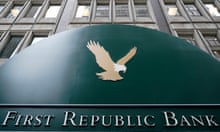Fresh from the rescue of First Republic, the latest US regional bank to go under, JP Morgan’s chief executive, Jamie Dimon, has been talking down the threat of contagion.
He claims the domino effect that started with Silicon Valley Bank’s collapse and was quickly followed by Signature Bank, Credit Suisse, and now First Republic, is coming to an end. “There may be another smaller one, but this pretty much resolves them all,” Dimon told analysts on Monday. “This part of the crisis is over.”
The boss of Wall Street’s largest bank undoubtedly has a vested interest in maintaining confidence in the financial sector. But even Dimon acknowledged that there are lingering risks, particularly in the US, where, he said, a fresh recession and higher-for-longer interest rates could reveal “other cracks in the system”.
Aside from Credit Suisse – which was limping along following decades of scandals – all of the lenders that have collapsed since March have been American. And furthermore, most were small to mid-sized lenders, which have been subject to weaker regulations since 2018. It meant they faced less oversight as customers pulled about $1tn-worth of deposits in the year to March, just as interest rates started to rise.
Growing fear over the wider health of the financial sector after Silicon Valley Bank’s collapse on 10 March sent regional bank stocks plunging. The market reaction in turn spooked customers, who started to withdraw their cash and park it with larger, more stable banks like JP Morgan.
With fewer deposits, banks are at risk of a liquidity crunch, since they could run out of quick cash to repay customers demanding funds. First Republic, for example, held roughly $174bn-worth of deposits the day before SVB failed, but went on to lose about $100bn in the weeks that followed.
Among the hardest hit were Dallas-headquartered Comerica, Zions Bancorporation, Trust Financial and KeyCorp – none of them household names. But unlike in the UK, smaller, regional banks play a much larger role in the American economy, accounting for nearly half of consumer and business lending.
It is a level of competition that UK regulators have been striving to stimulate for years, particularly in the wake of the financial crisis, when state bailouts and emergency takeovers gave further advantage to RBS and Lloyds Banking Group. Authorities have made some concession to boost growth and competition, but stopped short of loosening capital rules – a decision which is proving to have been sound, given recent turmoil.
In contrast, a decision by Trump-era politicians to repeal key regulation for small banks in 2018 is being blamed, in part, for the latest rout. The reform of the 2010 Dodd-Frank act raised the minimum threshold for banks subject to the stress tests, meaning those with less than $250bn in assets were no longer required to take part.
The reforms also watered down the Volcker rule that created a firewall between a bank’s consumer operations and its risky trading activities, and ensured that banks were not making bets against the interests of its customers.
after newsletter promotion
The changes meant banks like SVB could secure exemptions that allowed them to make risky investments, including in long-term bonds, which dropped in value amid rising interest rates and were harder to sell out of when customers demanded their cash at short notice.
Overall, the weaker oversight had widespread repercussions, especially since US lenders with less than $250bn in assets account for about 50% of business and industrial lending, 45% of consumer lending, and 60% of residential mortgages, according to Goldman Sachs.
They also account for 80% of commercial real estate loans, which could prove to be a bigger problem in the months ahead if work-from-home trends continue to chip away at the value of office space across the country.
Some American politicians are hoping that a revival of post-2008 regulations could help reduce the risks. A group of Democrat politicians led by the senator Elizabeth Warren are putting forward legislation meant to restore Dodd-Frank, though they are likely to face opposition from the Republican-controlled House of Representatives and some moderate Democrats.
In the meantime, investors will be hoping that Dimon’s assessment that the US banking system is “extraordinarily sound” proves correct.








